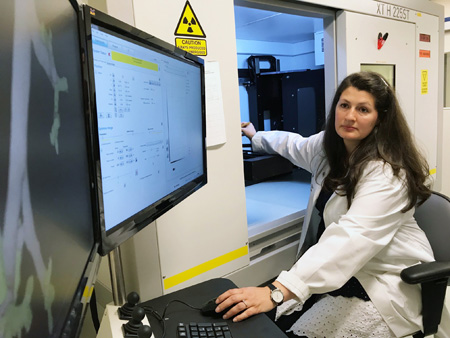Permanent lung damage caused by chronic obstructive pulmonary disease (COPD) starts much earlier than previously thought, even before patients are showing symptoms, according to research by the University of British Columbia.
The discovery, published this month in The Lancet Respiratory Medicine, could dramatically change how patients are treated for COPD, the leading cause of hospital admissions in B.C. and Canada.
COPD is a chronic, progressive condition that slowly damages the tissues of the lungs. Currently, patients with mild disease, as determined by a lung function test, are given minimal or no treatment.
The researchers found that patients diagnosed with even mild COPD have already lost a significant portion of their small airways — an average of more than 40 per cent.

Tillie-Louise Hackett using the microCT scanner that was instrumental in the discovery about COPD’s early destructiveness.
“These patients often have little to no symptoms, so it was believed their lungs were relatively undamaged,” said Tillie-Louise Hackett, Associate Professor in the Department of Anesthesiology, Pharmacology and Therapeutics. “Now that we know the severity of the damage, we need to look at earlier intervention to ensure the best outcomes for COPD patients.”
The new findings also suggest previous large clinical trials testing new COPD treatments may have failed because patients already had substantial lung damage.
“If the same drugs were tested on patients with more mild forms of the disease, and less tissue damage, the results could be very different,” said Dr. Hackett, a principal investigator at St. Paul’s Hospital Centre for Heart Lung Innovation (HLI).
Lung samples from 34 patients were analyzed using an ultra-high resolution micro-computed tomography (CT) scanner, one of only three scanners of this kind in the country. The HLI Lung Tissue Registry Biobank at St. Paul’s has been collecting specimens for more than 30 years, but the recent addition of the microCT scanner — funded by the Canada Foundation for Innovation and the St. Paul’s Foundation — made it possible to image samples that are embedded in paraffin in extreme detail.
It is estimated approximately one in 10 people over the age of 40 may suffer from COPD. Martin Mannette has been living with the disease for eight years. He is managing well with a careful combination of medication, but the 68-year-old is excited about how this research could impact future patients.
“I worry about COPD taking over as the number one killer,” said Mannette, “so anything we can do for the next generation so they can avoid COPD is so important.”
Professor of Respiratory Medicine Don Sin, the Canada Research Chair in COPD and a St. Paul’s respirologist, said the findings have significant implications. By 2020, COPD is expected to be the third leading cause of death worldwide.
“This breakthrough finding will allow us to develop new drugs to treat patients with COPD at the earliest stages of their disease when the disease is reversible,” Dr. Sin said. “This will prevent disease progression in thousands of patients and help them stay out of the hospital and remain healthy in their own homes.”